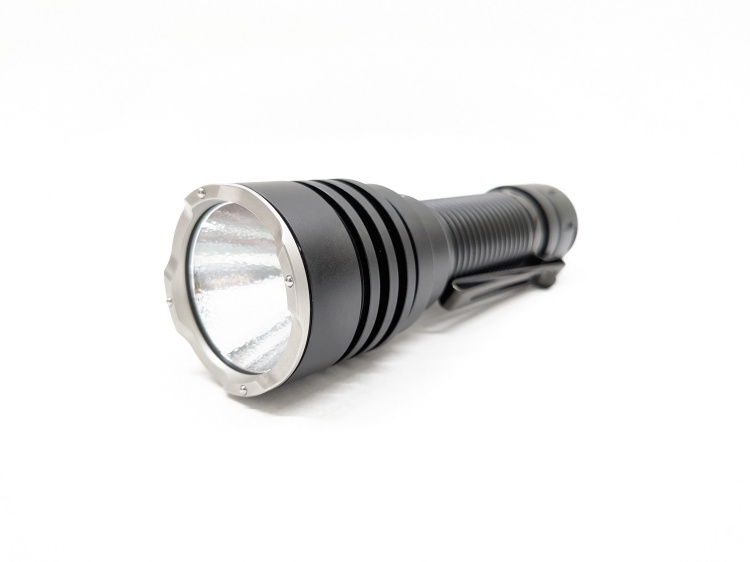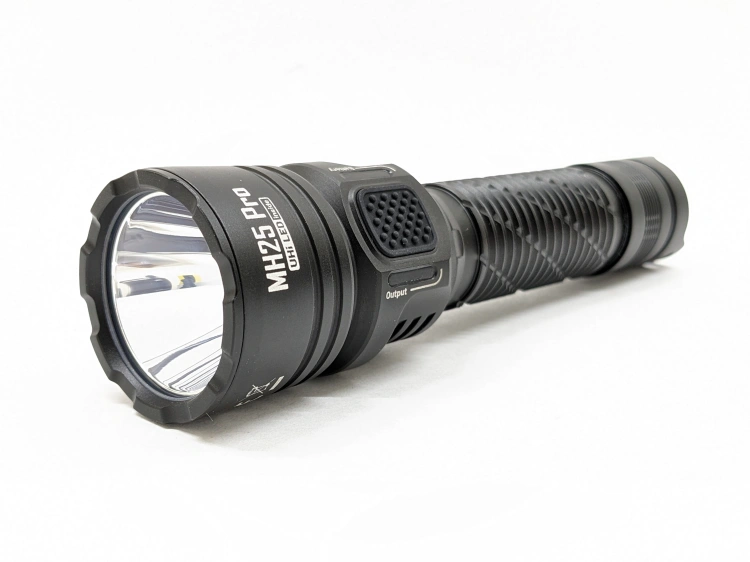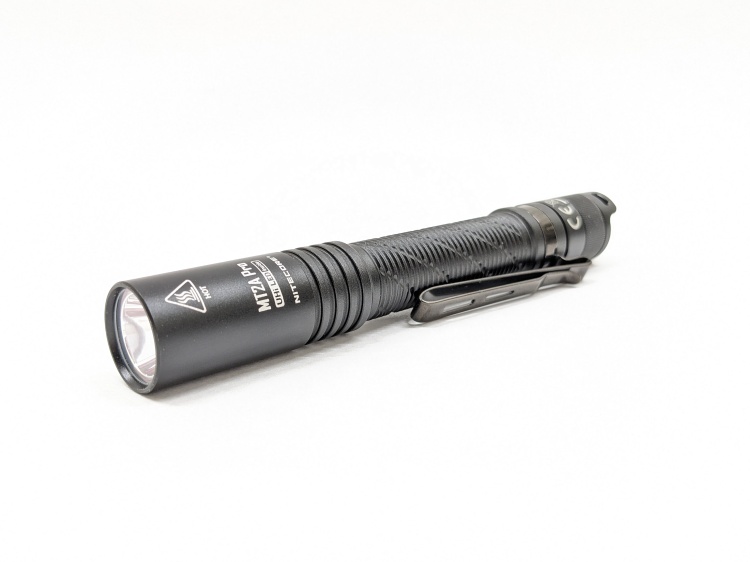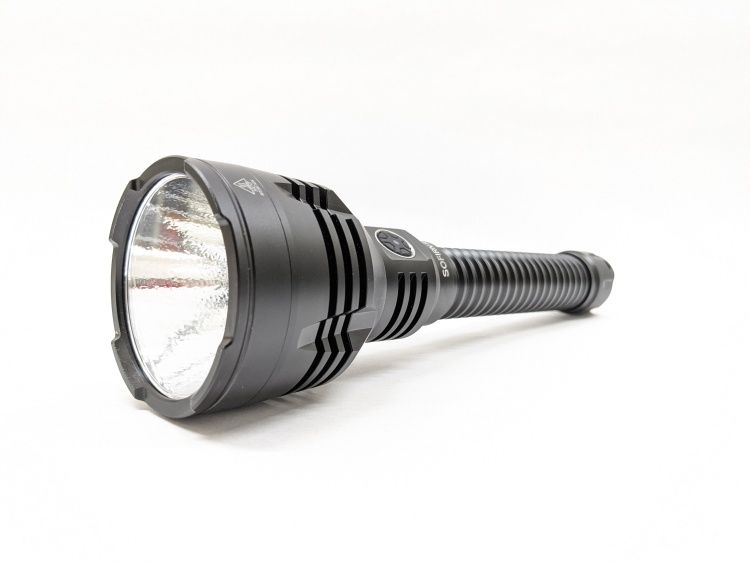Contents
- Pricing & Availability
- What comes in the box?
- Design & Construction
- Size & Measurements
- User Interface
- Mode Chart
- Runtime
- Driver & Regulation
- Emitter & Beam
- Switch
- Carry & Ergonomics
- Batteries & Charging
- Competition
- Conclusion
Pricing & Availability
Thrunite sent me this light in exchange for an honest review. Here is the official product page and the Amazon page where you can see current pricing. At the time of writing it’s $50, but there’s a 20% off coupon on the Amazon page.
What comes in the box?
The box is a little different than the previous Thrunite lights I’ve reviewed. It’s a one-piece cardboard box with a hinged lid rather than being two pieces of extra-dense cardboard like other. There are a couple of foam inserts inside to protect the light. I’m sure this packaging costs less and helps Thrunite get the price point down. The following items are included in the box:
- The light itself
- Battery (inside the light)
- Headband
- USB A-to-C cable
- User manual
- Spare o-rings
- Spare port cover
Design & Construction
Build quality is fairly good. I don’t have any complaints besides the tailcap threads being a little gritty. That won’t be a problem if you use the integrated charging, though. All the rest of the machining feels nice and the anodizing is applied well.

Size & Measurements
Emisar D4V2 | Sofirn D25LR | Thrunite “Thrower” | Emisar DW4 | Lumintop FW1A

| Measurement | Measured (mm) |
|---|---|
| Bezel Diameter | 23.5 |
| Maximum Head Diameter | 30.8 |
| Length | 108.8 |
| Switch Diameter | 18 |
| Switch Proudness | 2.3 |
| Lens Diameter | 21.9 |
| Lens Thickness | 1.3 |
| Reflector Hole Diameter | 7.6 |
| Reflector Diameter | 21.8 |
| Reflector Height | 10.6 |
| MCPCB Size | Weird shape |
| Body Tube Diameter (internal) | 19.14 |
| Body Tube Diameter (maximum) | 22.9 |
| Body Tube Diameter (mode) | 22.9 |
| Pocket Clip Slot Width | 6.3 |
| Pocket Clip Slot Diameter | 22.0 |
| Tailcap Diameter | 23.7 |
| Tailcap Length | 10.0 |
| Driver Diameter | Unable to Measure |
| USB Port Width | 11.9 |
| USB Port Depth | 3.2 |
| USB Port Height | 7.5 |
| Included Battery Length | 70.6 |
| Included Battery Diameter | 18.8 |
Weight without battery: 55g
Weight with included battery: 109g
Weight with included battery & headband: 158g
User Interface
This is a nice, simple UI.
The actions are # of presses followed by a hold (H) or a release (C). So, “1C” is one click and release. “2H” is two clicks but you hold down the last one.
| State | Action | Result |
|---|---|---|
| Off | 1C | On (mode memory) |
| Off | 1H | Firefly (not memorized) |
| Any | 2C | Turbo (not memorized |
| Any | 3C | SOS |
| On | 1C | Off |
| On | 1H | Mode cycle (Low > Med > High, memorized) |
What I like:
- 1 click on/off
- Firefly & Turbo both have dedicated shortcuts and are not memorized nor included in the normal mode rotation
- 1H from Firefly goes to Low (this is new, and a significant improvement over previous iterations of Thrunite’s UI)
- There are 5 brightness levels (that’s my preferred number of levels)
- No strobe mode (it’s annoying and somewhat useless on a headlamp)
- No electronic lockout (keeps the UI simple, mechanical lockout works fine)
What I don’t like (these are both very minor issues):
- 1H from Medium is inconsistent. If the light’s been on low for more than a second or two, 1H will go to Low. If the light’s been on Low for LESS than a second or two, it will go to High. It should always go to High.
- 2C from Turbo turns the light of briefly on the first click and then goes back to turbo again on the second click. Instead, it should go back to the memorized mode.
Mode Chart
Disclaimer: All of my measurements are taken at turn-on. Lumen measurements were taken on a Texas Ace 3.5″ Lumen Tube. A candela measurement was taken at 10 meters with an Opple Light Master III on the highest brightness, and other candela figures were calculated relative to that. CRI, CCT, & DUV data was taken for each mode from a few feet away at the center of the hotspot with the Opple Light Master and Waveform DUV Calculator. Runtime tests were performed with the Ceilingbounce app on my smartphone. All of these tests were performed with a fully charged included battery unless otherwise specified. I cannot measure moonlight directly, so moonlight readings are calculated based on the brightness relative to the next-lowest mode. None of this is professional equipment, so take all of these measurements with a grain of salt.

Above are the official specs, followed by my own measurements below.
| Level | Lumens | Candela | Throw (Meters) | CRI (Ra) | Color Temp. (K) | DUV (Tint) |
| Turbo | 1960 | 36000 | 379 | 68 | 6530 | 0.0034 |
| High | 470 | 8633 | 186 | 67 | 6310 | 0.0052 |
| Medium | 240 | 4408 | 133 | 66 | 6180 | 0.0061 |
| Low | 56 | 1029 | 63 | 66 | 6140 | 0.0060 |
| Firefly | 0.4 | 7 | 5 | 63 | 5650 | 0.0117 |
Mode Spacing: is OK. The middle 3 modes feel a little too close to each other and a little too far away from Turbo and Firefly. It’s not bad enough to be a problem though.
Runtime

Performance: is not bad. Just under 2000 lumens at turn-on is great and a “sustained” output of ~350 lumens (not counting downward voltage drift) is respectable for a light his small with a FET driver.
Thermal regulation: is present and work well but only after the initial timed Turbo stepdown at 1 minute. “Sustained” output increased to ~800lm when cooled.
LVP: is present in the light itself, not just in the battery. I observed LVP shutoff and measured resting battery voltage at 2.65V immediately after.
Driver & Regulation

Based on the downward drift in the runtime tests it’s clear that this is an unregulated FET driver, so I didn’t do any separate regulation testing. I strongly would have preferred a nice Buck driver for increased efficiency, even if it means a little bit higher price point. At the moderate brightness levels you’re likely to use a headlamp at most of the time, that extra efficiency really helps keep heat at bay and extend runtime. The body tube is glued onto the head so the driver is not removable.
PWM: No PWM is visible to my eyes or camera, nor audible to my ears. I did some testing on each mode with an Opple Light Master III and found PWM on Low, Medium, and High, but it’s fast enough you’d never know it was there without testing equipment.
Parasitic Drain: 22 microamps. That will take 17.6 years to drain the included batteries.
Emitter & Beam

Thrunite chose the best overall throw LED on the market right now: Luminus SFT40. They could not have picked a better LED here. It sits in a smooth reflector to maximize throw. I was unable to loosen the bezel retaining ring and get inside with normal tools, but I designed & 3D printed a bezel removal tool (STL) that did the trick though.
It’s pretty cramped in there. The MCPCB is a weird shape so emitter swaps may only be possible via reflow, and there aren’t really any other compelling 3V 5050 LED’s on the market at the moment.

The beam is very narrow for a headlamp. It’s kind of fun as a handheld because it feels a bit like a laser pistol. It’s surprisingly clean too, with the only artifacts being a ring outside the spill and six small spikes in the edge of the spill due to the cutouts on the bezel.




In the beamshots above, the trees where I’m aiming the hotspot are 175M away. In the beamshots below, the park bench where I’m aiming the hotspot is 42M away.




Switch

“Thrower” has an electronic switch and I have mixed feelings about it. I like that it’s clicky and that it’s backlit to show charge status. I don’t like that it’s very large and placed on the end of the head instead of the side. Using mechanical lockout when this light is in your pocket or bag may be necessary to prevent accidental activation. Placing the switch on the side of the head would be much better for use as a headlamp, and that’s the main use case for this light.
Carry & Ergonomics
“Thrower” wears fine. The headband is not the best though. I don’t like the silicone loop mounts that are common for right angle lights like this, and I also don’t like the non-removable top strap. It’s comfortable enough, but if I planned to use this light often I would buy a Skilhunt HB3 to replace the included headband.
There are no other carry methods included. I wish a magnetic tailcap and a good pocket clip were included though, as it would add to the versatility of this light.
In-Hand ergonomics are good if you want to use “Thrower” as a handheld light. When held in a pistol grip, you can use your thumb to actuate the button and the narrow beam points nicely.

Tailstand: works great and is stable
Batteries & Charging

“Thrower” includes a 3400mah protected 18650 battery. Unprotected flat top cells are safe to use, but they’re a little bit short so the light may turn off when jostled because the positive contact is a brass button instead of a spring. Any button top cell (protected or not) should be fine. You’ll want a cell rated for 10A current or more to get the best performance.

Charging is facilitated by a USB-C port on the side of the head. It’s covered by a rubber flap that works well enough, but I wouldn’t trust it for submersion. C-to-C charging works just fine and it’ll work while plugged in, but only in Firefly mode. There is no powerbank function present. When charging the switch will glow red, then it will turn blue when charging is complete. Charging took 2.5 hours and stopped at 4.18V.
Competition
“Thrower” really stands in a class of its own. There aren’t any other headlamps that I can find that throw half as well as this one. It’s a bit of a niche product, but it is the niche for the moment.
Conclusion
When Thrunite TH10 V2 was discontinued, it left a hole in the market for a very throwy headlamp. “Thrower” fills that hole fairly well, but it’s not perfect. I hope in the future that Thrunite will release an updated version with some minor UI tweaks, different button placement, nice Buck driver, magnetic tailcap, pocket clip, and a better headband. I think those upgrades would be worth paying an extra $10-20 for. With that said, this is without question the best thrower headlamp available at the time of writing. It’s ideal for situations like skateboarding where you need to be able to see far ahead to avoid bumps, or any other situation where you need hands-free long-distance light.
Thanks to Thrunite for sending me this light for review!
























